Kuruwitu Fishers Visit
At the end of February, we took 15 fishers from across Lamu County to visit Kuruwitu Co-Managed Area in Vipingo co-managed by Oceans Alive Trust, Kuruwitu CBO and a network of local Beach Management Units. This visit was kindly part funded by Stuart and Claudine Herd. Kuruwitu was the first community-led marine conservation area in Kenya and one of the few places King Charles visited on his recent Kenya visit!
Due to unsustainable fishing practices and other global challenges Lamu’s marine environment is becoming increasingly degraded. To counteract this destruction, fishing communities must be educated in sustainable fishing practices and the benefits of conservation activities such as seasonal closures, no take zones and changing fishing methods.
This community is notoriously difficult to influence and educate, many are stuck in their ways or happy to blame others for the degradation. It is also difficult to explain positive change without showing tangible results.
By running this visit, we were able to see the site under and on the water, talk with local fishermen and community members positively affected by the conservation area and have talk from the management team about how an area like this is run.
By taking fishermen to see the positive effects of conservation and talking to their peers we hoped they will become more open to new perspectives and these fishers can begin fostering a positive attitude towards conservation.
Fisher Selection
We selected the fishers who travelled with us through running a competition whereby participants sent a video sharing the reasons why they deserved to come on the visit with us. We wanted to ensure we received a fair representation of fishers from across the county.
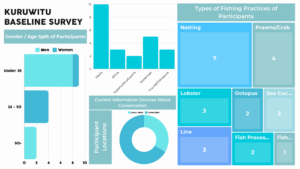
As you can see, a majority of fishers were from Lamu East, and most were men. This is representative of the fishing population in Lamu County as incomes are less diverse in Lamu East and more people are reliant on fishing. We were also very happy to have received so many videos from women involved in fishing. From Mama Karangas who prepare and sell fish for selling, to women who are involved in octopus closures and fishing in Pate.
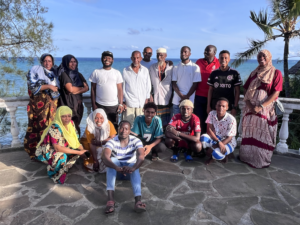
Baseline Survey Results
We travelled together by road to Vipingo in Kilifi County, where we met the Oceans Alive team and settled into our accommodation right on the beach! After we had settled in, all the fishers took a short survey to identify their current understanding of co-managed areas and marine conservation.
As you can see, the results are mixed. While the fishers have some knowledge of conservation practices and are also involved in many conservation practices, they don’t necessarily have the context to be able to explain why it’s important to focus on conservation. Fishers also have some reservations about undertaking conservation practices as some felt that it could limit their ability to earn an income and practice fishing freely.
See the results below:


Day One Activities
On the first day, we spent the morning learning from Kuruwitu co-founder Dickson who took the fishers through the history of Kuruwitu and what led them to setting up their bay as a protected area. Dickson, is a local fisherman, who prior to establishing Kuruwitu as a protected area in 2003 had little experience of marine conservation. However, he had seen how the ocean had changed – especially after the bleaching events after the last El Nino experience in the late 1990’s – and felt something must be done.
This history allowed the Lamu fishers to see how anyone can begin implementing marine conservation practices regardless of experience and knowledge – it all starts with passion for change!
After Dickson gave us the history, we were then shown all the multiple conservation projects the group undertake from school visits to climate smart gardening and how these all feed into a holistic conservation area. Finally, Dickson shared with us the positive impact of creating the first no-take zone in Kenya’s fisheries history. This included seeing an increase in the diversity of fish species within and bordering to the no-take zone and improved coral health and regeneration.

Later, we met Kuruwitu manager Tracey who showed us how the CMA is managed between the 3 partners. This was a key session where the Lamu fishers were able to get an idea of the complexities of managing a CMA and how it can only work if strong, trusting, and equal partnerships are created among all stakeholders.
After lunch, the team was excited to visit Oceans Alive HQ to see their onsite climate-smart gardens where the Lamu fishers were taken through different types of regenerative farming. Initially, the fishers were confused as to why a marine conservation organisation focused on farming. However, it became clear after the Oceans Alive team explained how food poverty is prevalent within the region – specifically during the off-season for fishing – so they’re working to transform food security by promoting homestead cultivation of vegetables.
The climate-smart kitchen gardens, use repurposed waste sacks and plastic containers filled with nutrient-rich soil and compost sourced from the land. These small-scale ecosystems require minimal space and water, offering an advantage in a region plagued by drought and limited access to water made worse by climate change.
The Lamu fishers were especially interested in how this could be replicated in Lamu given how expensive fresh food is and the challenges recently faced by the region after recent floods.
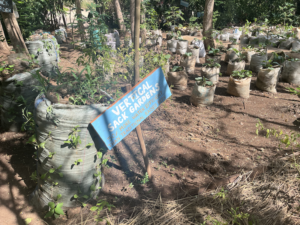
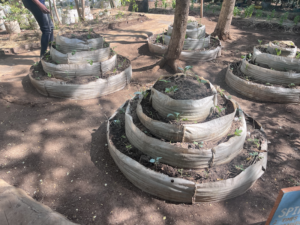
After our visit to the kitchen gardens, we visited the coral gardens! First, we met with coral restoration expert Katana who briefed us on land about how they restore coral underwater. Then we went on a glass-bottom boat ride to see some of the coral sites – due to the tides, we were unable to get a proper look underwater on this day…
Day Two Activities
This morning the tide was perfect for us to get in the water and see for ourselves how the restoration and no take zones have impacted the environment. We waded out at low tide and spent hours in the water seeing the coral restoration up close! It was a perfect environment for our fishers to really see how no-take zones positively affect the marine environment. While we were in the water we had an impromptu discussion where we talked about the types of conservation that happen in Lamu – specifically the octopus closures – and how this work can be replicated in Kuruwitu as well as how the coral restoration can work in Lamu. It was very beneficial for the fishers to see the numbers of fish, the difference between the coral in protected areas versus unprotected areas, and brainstorm challenges and opportunities in Lamu. And, for some of our fishers, this was the first time they’d seen coral up close to understand the fragility of these living things.
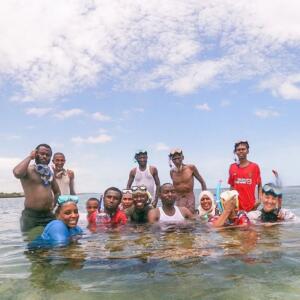
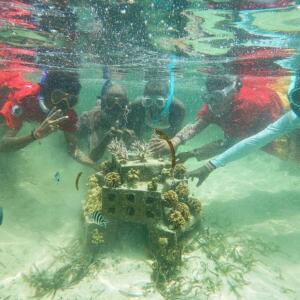
In the afternoon, we went back to base and discussed plastic pollution and waste management issues. Many of our fishers had experience of plastic collections from Lamu. Therefore, this was another example of how the experience of our Lamu fishers could really benefit the Kuruwitu community. Dickson explained the trash 4 cash program that supports community members to collect beach plastic that is then sold on to local recyclers.
The Lamu fishers were able to demonstrate their experience of house collections in Siyu in partnership with The Flipflopi Project to doing waste surveys in the mangroves and beaches to identify top polluters.
We also discussed everyone’s understanding of why waste is so bad for the environment. It was important that this was discussed as many people can say waste is bad, but often with little understanding of why. After this discussion, the group felt much more inspired and able to communicate the challenges with their community.
Review of Activities
En route back to Lamu, our fishers completed another survey to allow us to compare their understanding of CMAs and conservation before and after the visit. The results showed that everyone had a much greater understanding of conservation efforts and also had the language needed to communicate this too.


Promisingly too, all participants wanted to try out new conservation practices such as coral restoration and climate smart gardening while continuing the plastic collection activities they currently do.
The reservations that participants felt before the visit had also decreased significantly. While there was still concern about the challenges and practicalities of setting up a CMA the cooperation and professionalism they had witnessed in Kuruwitu was an inspiration. There were many discussions about how groups need to work together to achieve such a lofty goal and how this wasn’t currently the case in Lamu due to self-interest and a lack of long-term vision.
Overall, we feel this visit was hugely successful for us and all the fishers involved. Everyone went home full of inspiration and a desire to implement conservation practices in their area. We will follow up with all participants in the coming months and give another update on their activities and how they’ve been able to (or not) implement exciting new conservation practices in their area!
We also want to say a huge thanks to Mohamed Fuad, our wonderful facilitator on this trip without whom, this visit would not have been possible!
